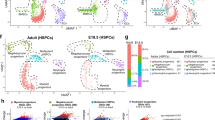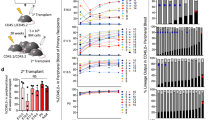Abstract
Core-binding factor β (Cbfβ) is the common non-DNA-binding subunit of the Cbf family of heterodimeric transcription factors. Mice deficient in Cbfβ have a severe block in fetal liver hematopoiesis at the stage of hematopoietic stem cell (HSC) emergence1,2. Here we show that by providing Cbfβ function in endothelial cells and hematopoietic progenitors we can rescue fetal liver hematopoiesis in Cbfβ-deficient embryos. The rescued mice die at birth, however, with severe defects in skeletal development, though intramembranous ossification occurs to some extent. Fetal liver hematopoiesis is restored at embryonic day (E) 12.5, but by E17.5 significant impairments in lymphopoiesis and myelopoiesis are observed. Thus, we conclude that the Cbfβ subunit is required for HSC emergence, bone formation and normal differentiation of lymphoid and myeloid lineage cells.
This is a preview of subscription content, access via your institution
Access options
Subscribe to this journal
Receive 12 print issues and online access
$209.00 per year
only $17.42 per issue
Buy this article
- Purchase on Springer Link
- Instant access to full article PDF
Prices may be subject to local taxes which are calculated during checkout



Similar content being viewed by others
References
Wang, Q. et al. The CBFβ subunit is essential for CBFα2 (AML1) function in vivo. Cell 87, 697–708 (1996).
Sasaki, K. et al. Absence of fetal liver hematopoiesis in transcriptional co-activator, core binding factor β (Cbfb) deficient mice. Proc. Natl Acad. Sci. USA 93, 12359–12363 (1996).
Jaffredo, T., Gautier, R., Eichmann, A. & Dieterlen-Lièvre, F. Intra-aortic hemopoietic cells are derived from endothelial cells during ontogeny. Development 125, 4575–4583 (1998).
North, T.E. et al. Cbfa2 is required for the formation of intra-aortic hematopoietic clusters. Development 126, 2563–2575 (1999).
Yokomizo, T. et al. Requirement of Runx1/AML1/PEBP2αB for the generation of haematopoietic cells from endothelial cells. Genes Cells 6, 13–23 (2001).
Sato, T.N. et al. Distinct roles of the receptor tyrosine kinases Tie-1 and Tie-2 in blood vessel formation. Nature 376, 70–74 (1995).
Schlaeger, T.M. et al. Uniform vascular-endothelial-cell-specific gene expression in both embryonic and adult transgenic mice. Proc. Natl Acad. Sci. USA 94, 3058–3063 (1997).
Yano, M. et al. Expression and function of murine receptor tyrosine kinases, TIE and TEK, in hematopoietic stem cells. Blood 89, 4317–4326 (1997).
Otto, F. et al. Cbfa1, a candidate gene for cleidocranial dysplasia syndrome, is essential for osteoblast differentiation and bone development. Cell 89, 765–772 (1997).
Komori, T. et al. Targeted disruption of Cbfa1 results in a complete lack of bone formation owing to maturational arrest of osteoblasts. Cell 89, 755–764 (1997).
Inada, M. et al. Maturational disturbance of chondrocytes in Cbfa1-deficient mice. Dev. Dyn. 214, 279–290 (1999).
Kim, I., Otto, F., Zabel, B. & Mundlos, S. Regulation of chondrocyte differentiation by Cbfa1. Mech. Dev. 80, 159–170 (1999).
Okuda, T., van Deursen, J., Hiebert, S.W., Grosveld, G. & Downing, J.R. AML1, the target of multiple chromosomal translocations in human leukemia, is essential for normal fetal liver hematopoiesis. Cell 84, 321–330 (1996).
Wang, Q. et al. Disruption of the Cbfa2 gene causes necrosis and hemorrhaging in the central nervous system and blocks definitive hematopoiesis. Proc. Natl Acad. Sci. USA 93, 3444–3449 (1996).
Li, Q.-L. et al. Causal relationship between the loss of RUNX3 expression and gastric cancer. Cell 109 (2002).
Levanon, D. et al. The Runx3 transcription factor regulates development and survival of TrkC dorsal root ganglia neurons. EMBO J. 21, 3454–3456 (2002).
Levanon, D. et al. Spatial and temporal expression pattern of Runx3 (Aml2) and Runx1 (Aml1) indicates non-redundant functions during mouse embryogenesis. Mech. Dev. 109, 413–417 (2001).
Hayashi, K. et al. Overexpression of AML1 transcription factor drives thymocytes into the CD8 single-positive lineage. J. Immunol. 167, 4957–4965 (2001).
Hayashi, K. et al. Diminution of the AML1 transcription factor function causes differential effects on the fates of CD4 and CD8 single-positive T cells. J. Immunol. 165, 6816–6824 (2000).
Yoshida, C.A. et al. Core-binding factor β interacts with Runx2 and is required for skeletal development. Nature Genet. 32, 633–638 (2002).
Deguchi, K. et al. Excessive extramedullary hematopoiesis in Cbfa1-deficient mice with a congenital lack of bone marrow. Biochem. Biophys. Res. Comm. 255, 352–359 (1999).
Castilla, L.H. et al. Chromosome 16 inversion-generated fusion gene Cbfb-MYH11 blocks myeloid differentiation and predisposes mice to acute myelomonocytic leukemia. Nature Genet. 23, 144–146 (1999).
Kundu, M. et al. Cbfβ interacts with Runx2 and has a critical role in bone development. Nature Genet. 32, 639–644 (2002).
Tahirov, T.H. et al. Structural analyses of DNA recognition by the AML1/Runx-1 Runt domain and its allosteric control by CBFβ. Cell 104, 755–767 (2001).
Nagata, T. & Werner, M.H. Functional mutagenesis of AML1/RUNX1 and PEBP2β/CBFβ define distinct, non-overlapping sites for DNA recognition and heterodimerization by the Runt domain. J. Mol. Biol. 308, 191–203 (2001).
Mundlos, S. et al. Mutations involving the transcription factor CBFA1 cause Cleidocranial dysplasia. Cell 89, 773–780 (1997).
Zhou, G. et al. CBFA1 mutation analysis and functional correlation with phenotypic variability in cleidocranial dysplasia. Hum. Mol. Genet. 8, 2311–2316 (1999).
Motoike, T. et al. Universal GFP reporter for the study of vascular development. Genesis 28, 75–81 (2000).
Rucklidge, G.J., Milne, G. & Robins, S.P. Collagen X: a component of the surface of normal human, pig, and rat articular cartilage. Biochem. Biophys. Res. Comm. 224, 297–302 (1996).
Acknowledgements
We thank A. Given, G. Ward, M. Kundu, M. de Bruijn, M. Binder, B. Trevant and S. Fiering for their advice and technical assistance, L. Karns for the Tek promoter and enhancer sequences and T. Sato for the Tg(Tek-GFP) mice. This work was supported by US Public Health Service grants to N.A.S., J.B.L. and G.S.S. and supported in part by the Core Grant of the Norris Cotton Cancer Center.
Author information
Authors and Affiliations
Corresponding author
Ethics declarations
Competing interests
The authors declare no competing financial interests.
Rights and permissions
About this article
Cite this article
Miller, J., Horner, A., Stacy, T. et al. The core-binding factor β subunit is required for bone formation and hematopoietic maturation. Nat Genet 32, 645–649 (2002). https://doi.org/10.1038/ng1049
Received:
Accepted:
Published:
Issue Date:
DOI: https://doi.org/10.1038/ng1049
This article is cited by
-
Osteoblast-derived vesicles induce a switch from bone-formation to bone-resorption in vivo
Nature Communications (2022)
-
The relationship between abnormal Core binding factor-β expression in human cartilage and osteoarthritis
BMC Musculoskeletal Disorders (2021)
-
Zfhx4 regulates endochondral ossification as the transcriptional platform of Osterix in mice
Communications Biology (2021)
-
Ezh2 is essential for the generation of functional yolk sac derived erythro-myeloid progenitors
Nature Communications (2021)
-
CBFβ promotes colorectal cancer progression through transcriptionally activating OPN, FAM129A, and UPP1 in a RUNX2-dependent manner
Cell Death & Differentiation (2021)



